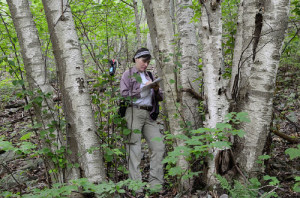Well-established populations of three new, introduced plants have been documented in Virginia during the 2013 field season.
Aldrovanda vesiculosa L. (waterwheel plant), a carnivorous aquatic in the Droseraceae, was found to be abundant in parts of an old, large impoundment at Fort A.P. Hill Military Reservation in Caroline County. Evidently escaped from a nearby cultivated population, these plants represent one of only a few North American records for this Old World species.
Numerous individuals of Alnus glutinosa (L.) Gaertn. (black alder) were discovered in a small, weedy creek bottom adjacent to a golf course and old estate in Washington County. Previous reports of single, escaped trees in Arlington and Fairfax counties did not seem substantial enough to consider this species “established” in the state. This European alder is frequently used in wetland restoration plantings, and has been reported as invasive in seven states north of Virginia.
A low, sprawling, small-flowered Geranium found on a rich rocky embankment along Skyline Drive in Shenandoah National Park (Page County) proved to be Geranium sibiricum L. (Siberian cranesbill). The plant occurs for some distance along the Drive at this site and has obviously been undetected for some time. This Eurasian species is well established in a number of state north and northwest of Virginia.
More information is available on the individual map pages for these species.
